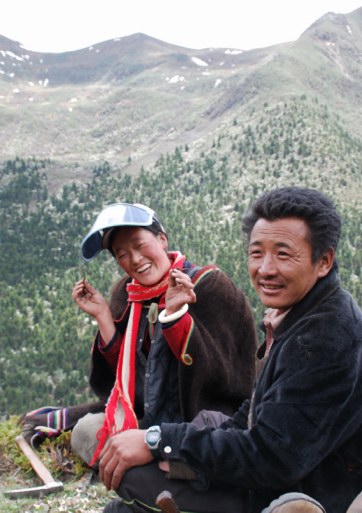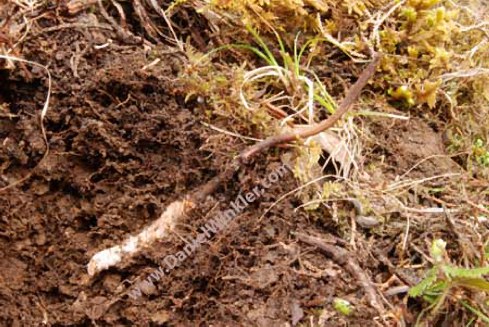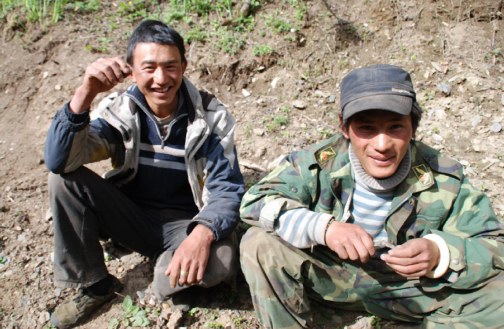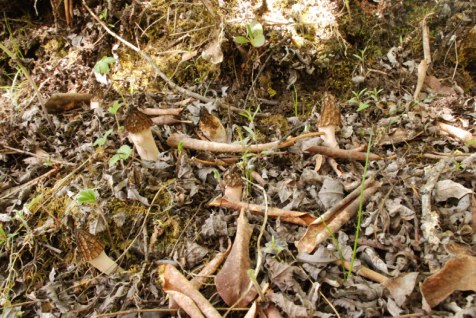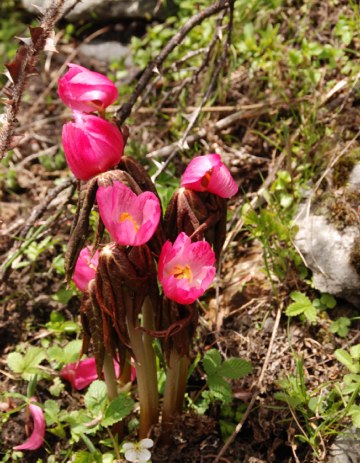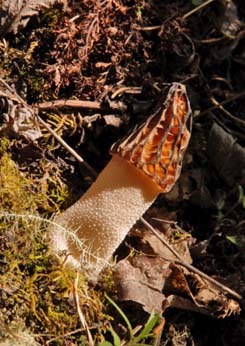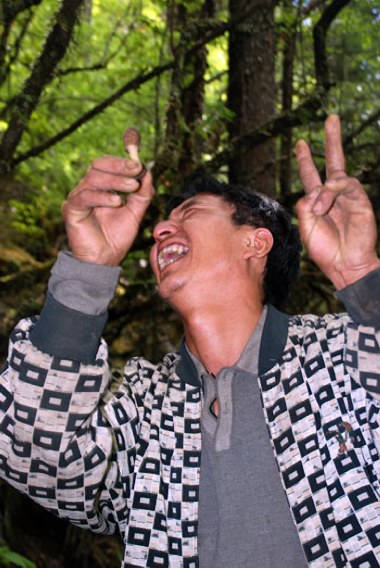to Dechen Tibetan Autonomous Prefecture - Yunnan Province
Pick up at airport. Morning visit to the Botanical Garden in Heilongtan and Kunming Institute of Botany.
Short visit to Kunming's best bookstore, Dinner at the Restaurant Yunnan Mushroom King.
Feasting on: A bolete, close in taste to Boletus edulis, according to the chef Boletus ornatipes, "Qisong", a Termite mushroom, (Termitomyces eurrhizus), "Ganbajun", Thelephora ganbajun & veiled stink morel (Dictyophora indusiata). Green Lake View Hotel.
|
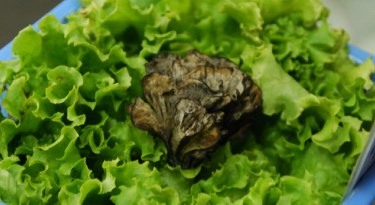 A small fresh Ganba Jun presented on salad leaf
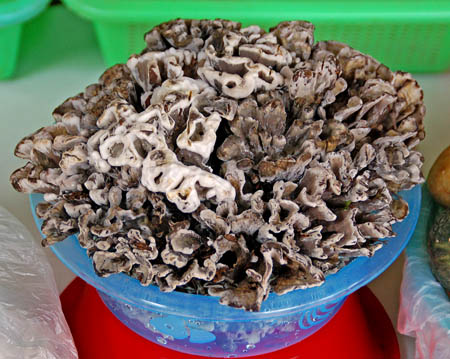 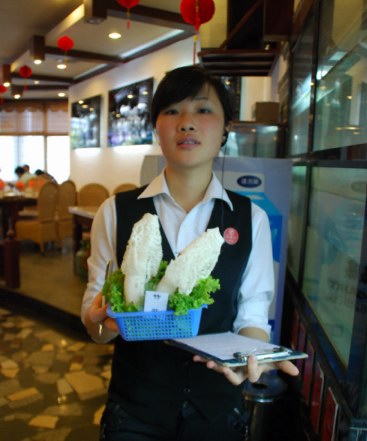 The veiled stink morel (Dictyophora indusiata) is a 25 cm tall morel-like tropical fungus with a beautiful lacy veil allowing insects to climb up to eat its gleba and thus spread its spores. impresses most by its uncooked look. For eating the spore bearing cap is removed. Past preparation it has a firm, but spongy texture that is interesting, whereas the aroma is very mild. The fresh soy leaves greens in the broth seemed to contribute more to the taste of the soup than the fungus.
|
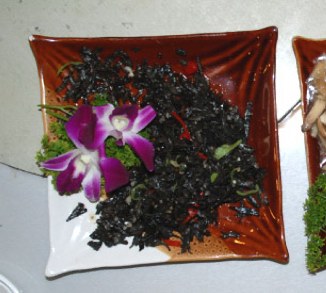 The great surprise is ganba jun (Thelephora ganbajun), a woody mushroom whose common relative Th. terrestris is known in English as "earth fan". "Ganbajun", is often described as Thelephora ganbajun, but not all taxonomists agree on this name and use older ones, such as Thelephora vialis, T. aurantiotincta or T. japonica, which are all eaten in Yunnan. However in the fried state I could not figure out which Thelephora was on my plate and I was not going to let it get cold over such a theoretical question. Thelephora species are not regarded edible in most places where it is growing, but in Yunnan it is one of he most precious edibles. It is "rendered" edible, by slicing it very finely. Then its chewy nature turns into an interesting texture. I would describe it as having a strong earthy element, being slightly bitter, but in a pleasant way.
On the left Thelephora ganbajun, known in Yunnan as 干巴菌 Ganba Jun, for sale on the market in Kunming. A pound cost 120 Yuan, whereas matsutake cost 40 Yuan and the price of the matsutake is dictated by the international trade, since most of the harvest is flown to Japan..
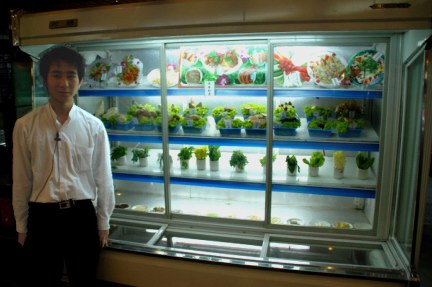 The dinner at the "Mushroom King" was quite an experience. We could chose from two dozens of mushrooms, most of them fresh, displayed on salad leaves. I recall veiled stinkhorn (Dictyophora indusiata), black morels (Morchella sp.), several boletes (Boletus spp.), milky cap (Lactarius deliciosus), termite mushroom (Termitomyces eurrhizus), inky caps (Coprinus sp.), Oysters (Pleurotus ostreatus, P. eryingii), earth fan (Thelephora ganbajun), deceiver (Laccaria laccata), a purplish hawkwing (Sarcodon sp.), Shiitake (Lentinula edodes) and Enoki (Flammulina velutipes). It would be interesting to see their list during mushroom season!
|
27-May Tue: Kunming - Lijiang
Visit of Kunming's mushroom market. Most impressive besides fresh stinkhorns (Dictyophora indusiata) and their "eggs" were half a dozen species of boletes (Boletus obscureumbrinus, B. bicolor, B. ornatipes, a few B.edulis, a brightly red pored bolete and Boletus speciosus "bai chong niugan jun", a yellow-pored silvery bolete). Also we saw lots of ganbajun (Thelephora), which costs about 10 times as much as king boletes, Shield Pinkgill (Entoloma clypeatum), Termite mushroom (Termitomyces sp). milky cap (Lactarius deliciosus), lots of dried truffles (kai jun, Tuber indicum) and bags of this year's freshly dried morels (Morchella spp.) collected in the Tibetan areas.
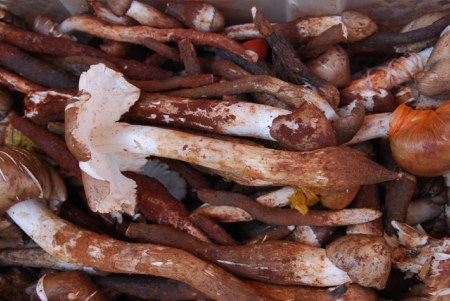 Termites knew what they were selecting for in their millions of years of fungal cultivation! Termite mushroom (Termitomyces sp.)have a great sweetish-nutty taste.
|
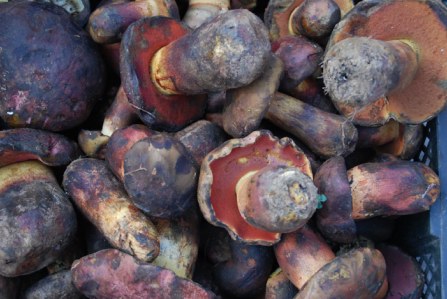 This could well be the Red-stemmed bolete, Boletus erythropus, a choice edible after cooking.
|
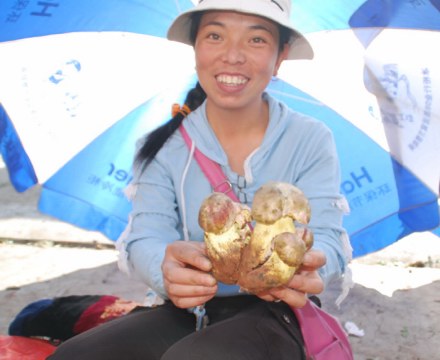 A market women offering a Butter bolete Butyriboletus sp. "bai chong niugan jun".
A happy shopper holding an impressive cluster of
Boletus obscureumbrinus.
|
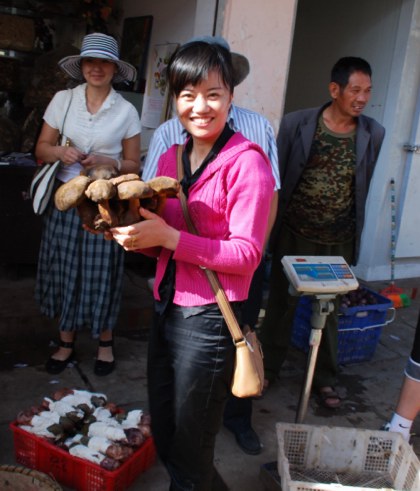 |
At noon flight to Lijiang. Visit to a local mushroom farm. The owner, He Jie, grows button mushrooms (Agaricus bisporus) on straw and cow manure in wood shelves. The growing houses are made from simple wooden structures and covered with plastic and a bamboo mats for insulation.
Visit of the picturesque old town of Lijiang, the heart of the Naxi / Nakhi-culture, protected as UNESCO world heritage site. Lijiang Grand Hotel.
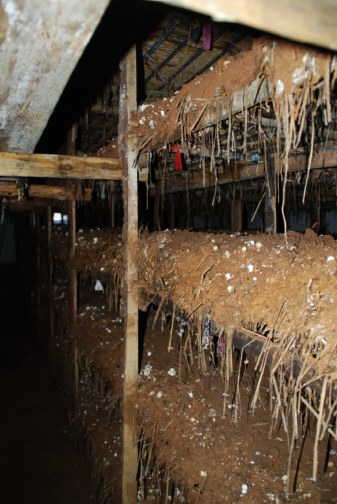 |
 |
|
Who says growing mushroom needs to be in a sterile, high tech environment?
Near Lijiang airport we visited He Jie, a mushroom grower operating a local mushroom farm. He grows button mushrooms (Agaricus bisporus) on straw and cow manure in wood shelves. Several greenhouse-like structures are made from simple wooden frames covered with bamboo mats for insulation and with plastic to retain moisture. The growing houses are looking more like Lake Titicaca reed houses than a mushroom growing operation. Interestingly, the grower used straw and cow manure. He was relying on the same mycelium he had bought eight years ago.
|
|
28-May Wed: Yulong Xueshan Nature Preserve, afternoon drive to Gyalthang (= Zhongdian / Shangrila / Xianggelila)
Visit of Yulongshan Nature Preserve. Gondola-ride to 4506m (13,920ft) with view onto glaciers and the peak (5596m, 18,359ft). Picnic in flower meadow (Iris ruthenica var. nana, Stellera chamaejasme, Roscoea tibetica & Roscoea cautleoides (yellow), Euphorbia, Androsace delavayi, close by red tree-peony Paeonia delavayi). Futile morel hunt in forest fire area with lady slipper (Cypripedium guttatum).
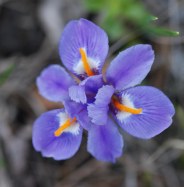 Iris ruthenica var. nana
|
 Stellera chamaejasme
|
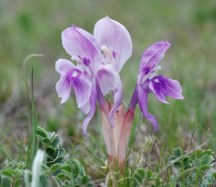 Roscoea tibetica
|
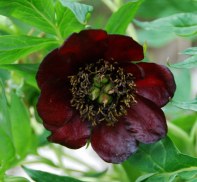 Paeonia delavayi
|
Afternoon drive along the Yangtze River (2500m, 7750ft) and stop in Rhododendron shrub-lands before Gyalthang (3300m, 10,200ft). Welcome meal at Arro Khampa Restaurant. Gyalthang Dzong Hotel
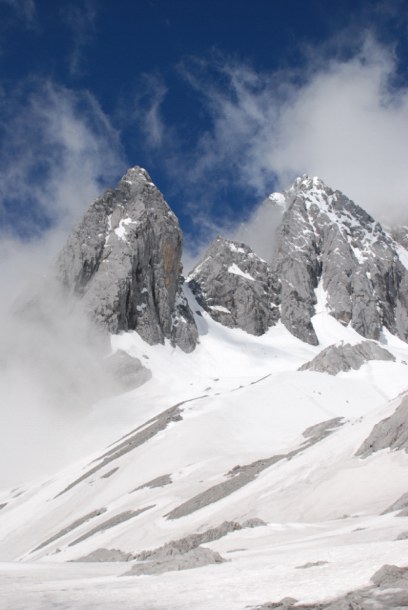 Yunnan's Yulong Xueshan range, which supports Asia's southernmost glaciation.
|
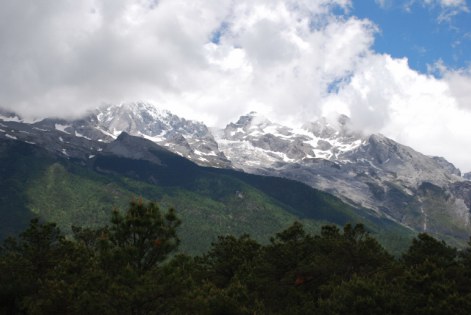 The Yulong Xueshan range with a few pines in foreground
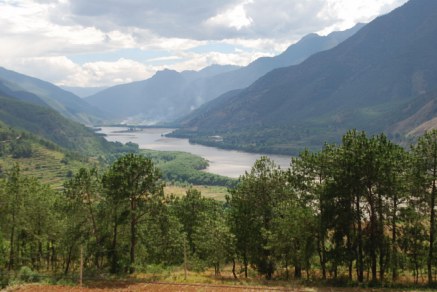 The Yangtse valley
|
29-May Thu Gyalthang (= Zhongdian, Shangrila / Xianggelila)
Morning visit to Songtsen Ling Monastery (Gelukpa 17th Century), Napa Lake Nature reserve with yellow Daphne calcicola and scarlet Gloxinia Incarvillea zhongdianensis.  Visit of the mushroom market with Dr. Xu, mycologist at Kunming Institute of Botany. Several species of fresh morels are spread out for drying. Dr Xu points out a flesh-colored species, which could be Morchella bicostata Chen & Liu. Mushroom hunt in a young birch-pine-larch forest with Leccinum cf. versipelle, Coriolus sp., a brown Suillus associate with larch, as well as Rhizopogon rubescens. The latter also known by its Japanese name Shoro was enjoyed for dinner at the forest bureau restaurant. Visit of Dukhar Dzong Old Town. Gyalthang Dzong Hotel
Visit of the mushroom market with Dr. Xu, mycologist at Kunming Institute of Botany. Several species of fresh morels are spread out for drying. Dr Xu points out a flesh-colored species, which could be Morchella bicostata Chen & Liu. Mushroom hunt in a young birch-pine-larch forest with Leccinum cf. versipelle, Coriolus sp., a brown Suillus associate with larch, as well as Rhizopogon rubescens. The latter also known by its Japanese name Shoro was enjoyed for dinner at the forest bureau restaurant. Visit of Dukhar Dzong Old Town. Gyalthang Dzong Hotel
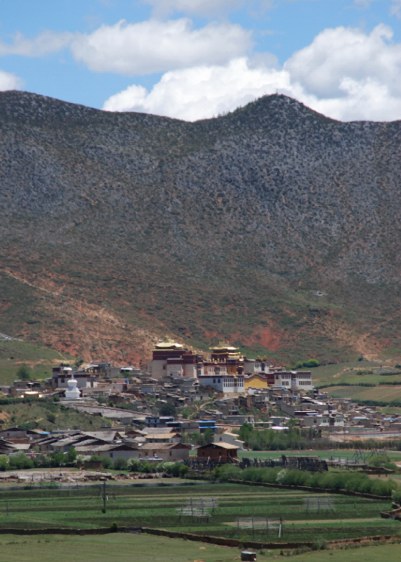 Songtsen Ling Monastery near Gyalthang
|
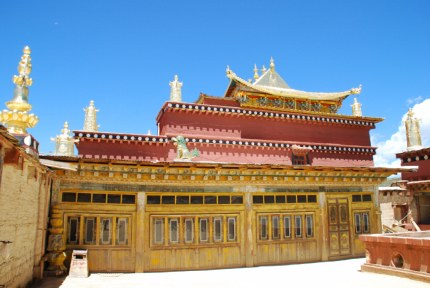 On the main roof of Songtsen Ling.
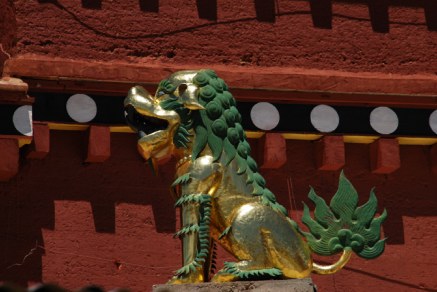 A snow lion, one of Tibet's four mystical animal guardians, is protecting the temple.
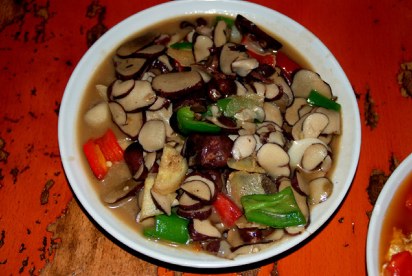 Rhizopogon rubescens, Shoro, served at the at a local restaurant. I was not impressed by the potato-like"starchiness".
|
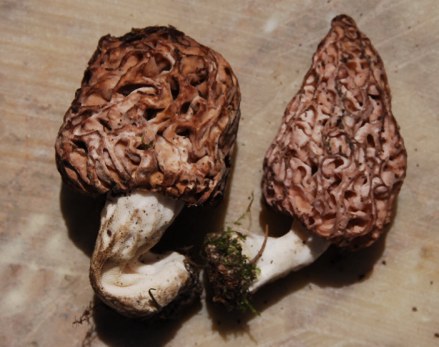 At the mushroom market we encountered these pinkish morels, which according to Dr. Xu are probably Morchella bicostata Chen & Liu.
|
30-May Fri Gyalthang - Wang Shor
Drive on the Gyalthang - Chatreng (Xiangcheng, Sichuan) Highway to Birong Gorge. Crossing of extensive clear cuts. Afternoon excursion to Namri Butong and short hike on mountain meadows in 4100 m, (12,700 ft) where locals collect Yartsa Gunbu, Cordyceps sinensis - caterpillar fungus. On the way up we meet Losang Yangzom and her group of morel pickers who are cooking tea after a long day of morel hunt. Wang Shor Guesthouse.
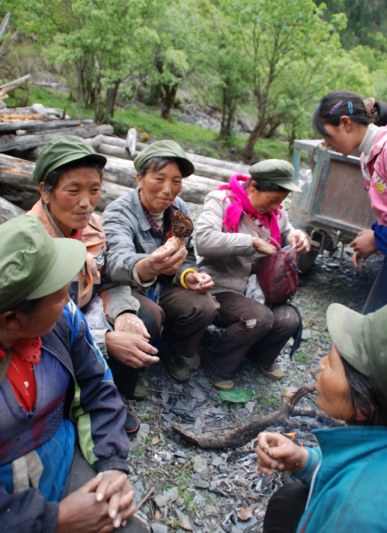 Losang Yangzom holding up a morel while taking a break before heading home after a day of morel picking.
|
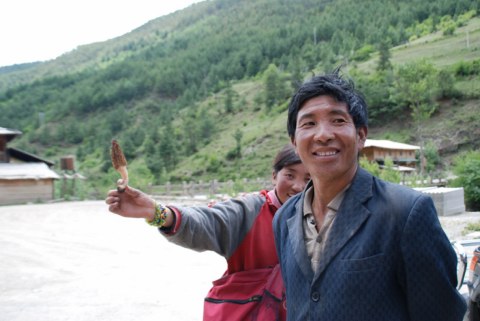 A mushroom collector shows a fresh morel while hiding from the camera.
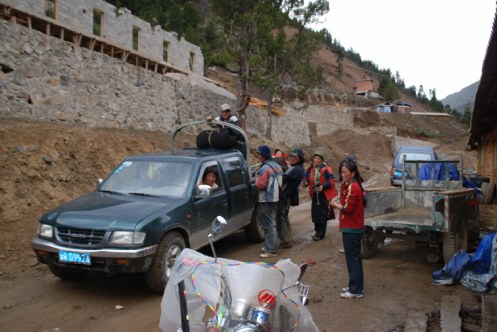 Bu hunters loading their tents. For them the season is over. In the back construction for a copper mine. Across the ridge is Pulong Copper mine, supposedly the biggest in China with an investment volume of ¥4.4 billion(US$ 640 million). The valleys drain into the gorgeous Birong Valley, which is renowned for its incredible biodiversity.
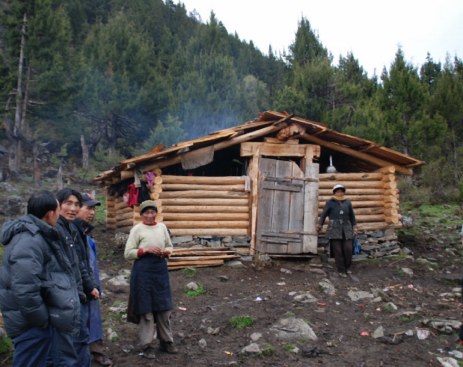 A hut recently build to accommodate collectors during the season. Night frost are common, and snow shower occur frequently.
|
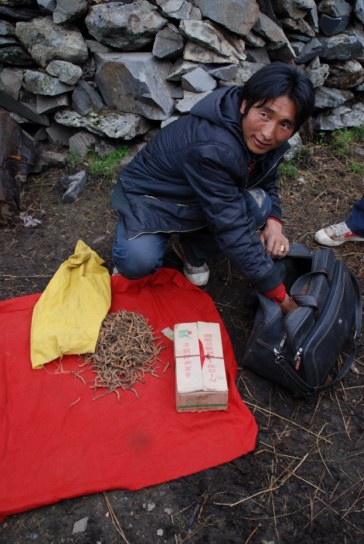 A bu dealer showing us the caterpillar fungi he had bought up. He drives to the remote collection areas and buys directly from collectors.
|
31-May Sat Wang Shor - Namri Butong
Yartsa Gunbu hunt (4000 m-4300 m, 12,400-13,300 ft) with Tendzin in Namri Butong. Bu found in open subalpine Rhododendron-Juniper forest on the South slope in 4200m (13,000 ft). Picnic with Tendzin and Wangmo on alpine pasture in 4300 m (13,300 ft). Afternoon morel hunt with Tashi Wangden (23) & Kelsang Dhondrub (21) from Wang Shor in 3750 m (11,625 ft) in degraded willow-evergreen oak forest on the South slope. All morels found under willows. Flowers: May apple - Podophyllum hexandrum, Primula amethystina var. brevifolia (on the pastures), yellow Himalayan poppy:Meconopsis integrifolia, Omphallogramma vincaefolia (Primula-like), tall Iris bulleyana (40 cm, 16"). Wang Shor Guesthouse
Drive back from Wang Shor to Gyalthang via Geza. Botany stop in Birong George: orchids (Pleione yunnanensis and a yellow lady slipper: Cypripedium flavum) as well and Iris (Iris reticulata var. nana).
Visit of a mambo, monument for a protector deity. Cuckoo stop next to a clear cut. The Tibetan name for the morel is `khukhu shamo', cuckoo mushroom, since the mushroom and the cuckoo show up at the time in spring.
Visit to the old town of Gyalthang and dance. Gyalthang Dzong Hotel
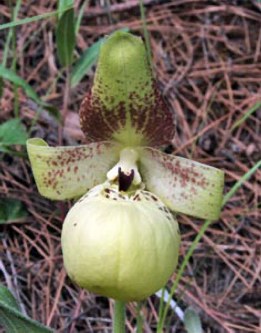 Flower of lady slipper orchid
|
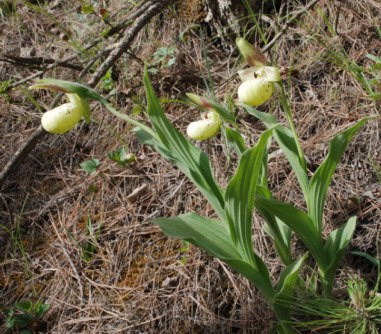 Yellow lady slipper (Cypripedium flavum)
|
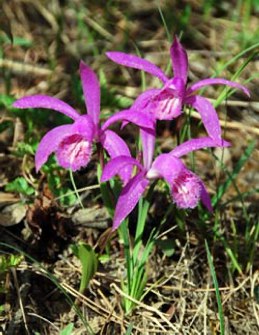 Pleione yunnanensis
|
2-Jun Mon Gyalthang
Visit with Dr. Ma Liming from the Gyalthang Tibetan Hospital. Interview on the use of Cordyceps sinensis in Rigpa Sowa, Tibetan Medicine. Visit of the outdoor Yartsa gunbu market and of other natural medicine shops in Gyalthang. Afternoon bath and sauna in the natural hot springs of Rangjung Dosam (Tiansheng Qiao). Gyalthang Dzong Hotel.
 Marc, Therese and Franz visiting with Dr. Ma Liming in Gyalthang's Traditional Tibetan Medicine Clinic. We interviewed Dr. Ma onCordyceps use in Tibetan Medicine.
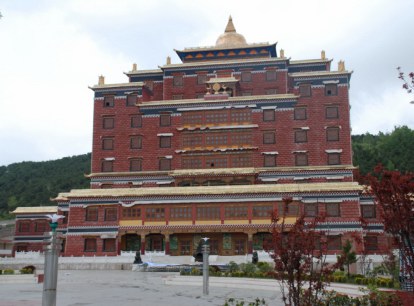 A brand new building in Gyalthang in traditional Tibetan style. We were told it would be housing a collection of statues and other Tibetan artifacts collected by a Tibetan entrepreneur. However, it wasn't open yet in June 2008.
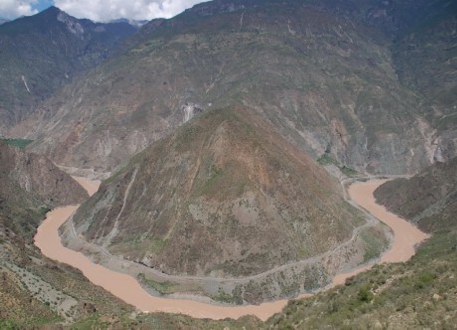 The famous Yangtze bend in Dechen Tibetan Autonomous Prefecture, NW Yunnan. For scale, please note the road following the river. The Yangtze has ten times the water volume during the summer monsoon in comparison to the winter run-off. In winter it flows in beautiful clear blue. © Daniel Winkler, July 2007
|
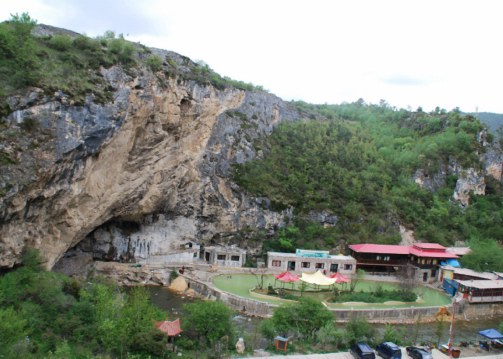 Geothermal springs Rangjung Dosam (Tiansheng Qiao) 25 min from Gyalthang. Big hot pool, steam cave, cooling off in the river, awesome setting. These springs, although developed, are great!
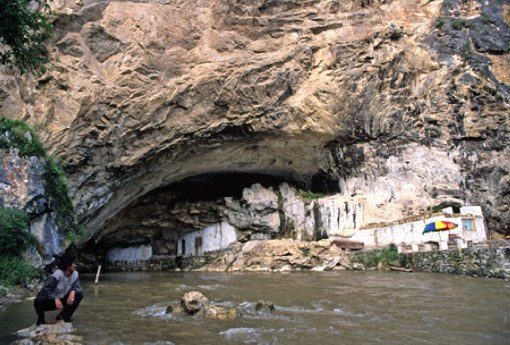 The river tunneled its way through the limestone. The steam bath is build along the sites of this passage
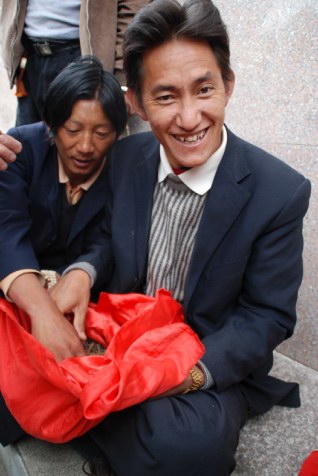 Don't you wonna buy some of my nice yartsa gunbu?
|
3-Jun Tue Drive to Feilaisi, Dechen.
Stop in Tsering Drolma's house in Gonjo village, built along the Gonjo Chu (2000 m, 6200 ft). Village is renowned for its many wood workers. Shopping in Pondzirak / Benzilan, located on the Yangtze River. Visit of the scenic spot overlooking the 270° Yangtze bend. Visit of Ganden Dondheling Monastery (Gelukpa tradition) founded in 1667 and blessed by the Great 5. Dalai Lama in 1670. Drive across Pema Karpo / Baima Xueshan Nature Preserve and Jol Gonsong Pass (4200 m, 13,000 ft). Drive to Dechen town and Namkha Tashi / Feilaisi. Minzhu Hotel.
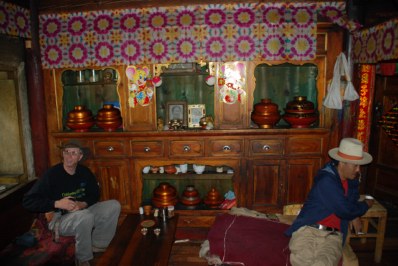 Visiting the home of Tsering Drolma's house in Gonjo.
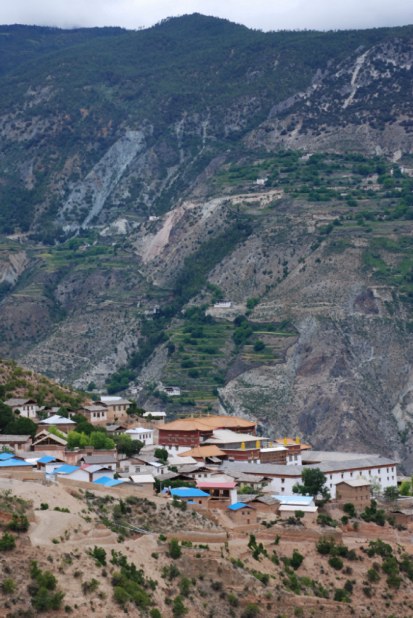 Ganden Dondheling Monastery founded in 1667
|
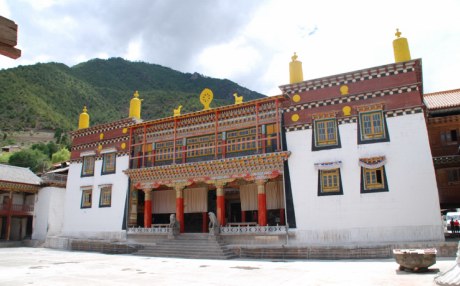 Front of the main Prayer Hall in Ganden Dondheling Monastery.
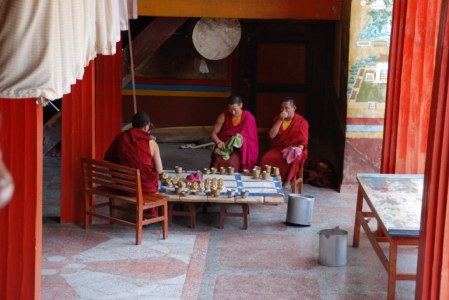 Monks cleaning water bowls for an offering ritual.
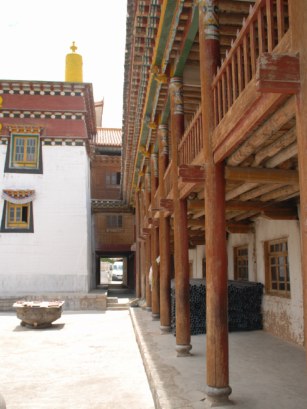 |
4-Jun Wed Namkha Tashi & Pema Karpo Pass
Morning in Namkha Tashi Lhakhang / Feilaisi vista spot (3480m 11,500 ft) above the Mekong (Gyalmo Ngul Chu / Lancang Jiang). Kawa Karpo / Meili Xueshan (6740m / 22,200ft) in clouds. Drive up to Pema Karpo / Baima Xueshan, which is covered in snow. Return to Namkha Tashi. Afternoon in the café house. Slide show. Kawa Karpo in plain view. Dinner with matsutake soup, shiitake and fiddle-heads. Minzhu Hotel.
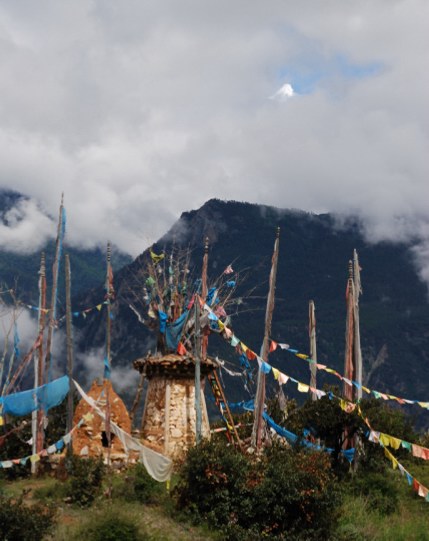 |
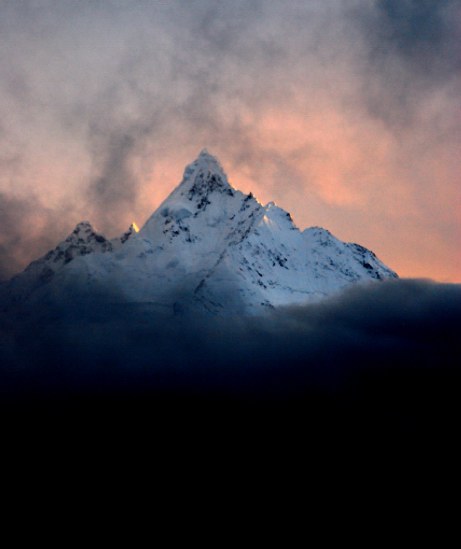 |
|
Twice Kawakarpo, one of Tibet's four most sacred mountains and seat of a mountain deity. So far, everyone who tried to climb southeast Tibet's highest peak (6740m / 22112 ft.) failed and many mountaineers died.
On the upper left there is only its peak poking through the clouds. Clouds are a very common feature of this giant. In front a small Chörten (Stupa) and a "Sang"burner for smoke offerings surrounded by prayer flags. In Chinese Kawakarpo, which sits between the Mekong and Salween Rivers, is known as Meili Xueshan.
|
|
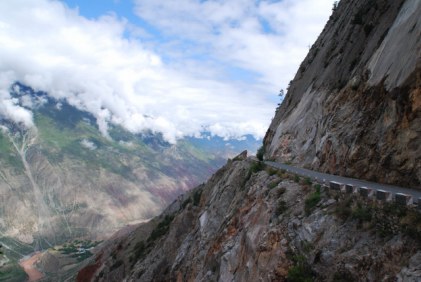 Deep down in roughly 2000m / 6500 ft runs the Mekong river.
|
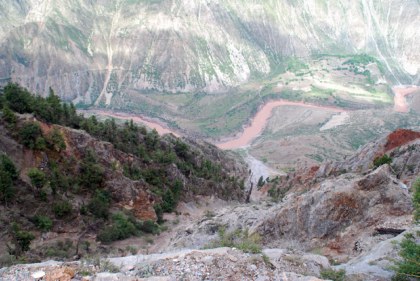 It is "convenient" not to stray from the road.
|
5-Juni Thu Hong village, Dechen & Namkha Tashi
Drive along the Mekong gorge and the Khawakarpo range (Meili Xueshan) to Hong village (3000m, 9,300ft) in Yongning District, Dechen County (Deqing). Visit of Liu Sin / Losang's house, the village doctor (= Amchi). Hike in a Pine-spruce-fire-Douglas fir (Pseudotsuga forrestii) - forest above Hong. Group split: relaxing out in nature (3300m, 10,200ft) and morel hike with Losang and Wangdu up to 3800m (11,800ft) Morels grow in a Rhododendron-fir-North-slope forest. Minzhu Hotel.
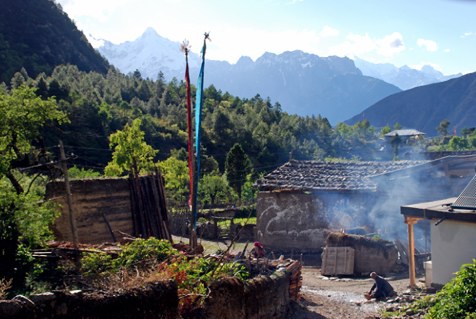 Looking onto the Khawa Karpo Range [Meili Xueshan 6740m / 22112 ft] across the Mekong valley. Note the solar water heater on the bath house (lower left).
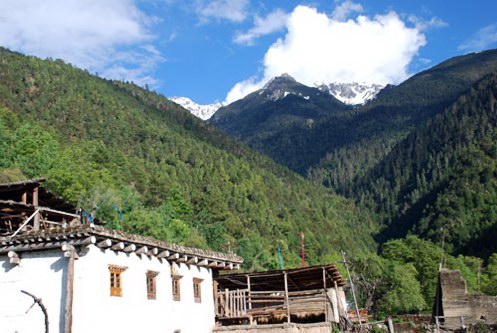 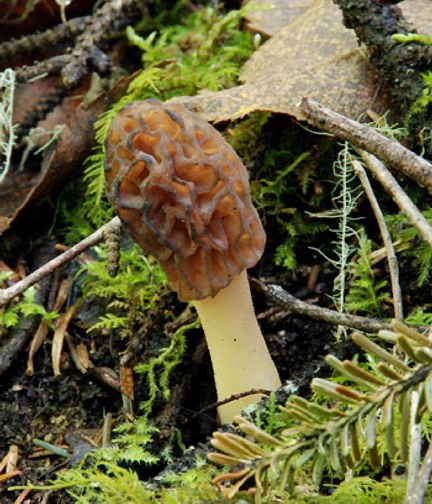 |
Hong Village with peak from Pema Karpo Mountains
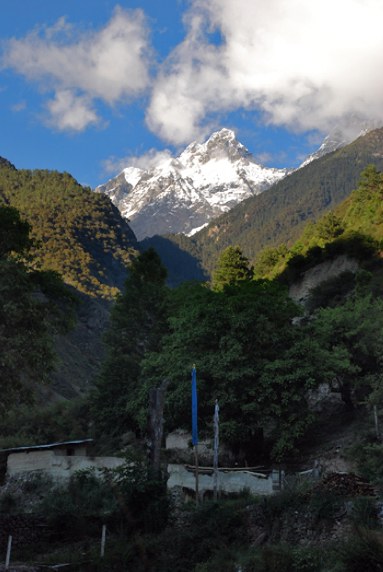 |
|
Lin Sen (Tibetan: Losang), the village Amchi (doctor) was all excited about the "khukhu shamo" he found. We were quite late in the season and had to search subalpine conifer forests for the last morels after some demanding, but incredibly beautiful, climbing along a mountain creek grown in by bamboo thickets. Commercial picking was basically over at this point, since it was very arduous and slim picking.
Photos: Daniel WInkler, June 3, 2008, Hong Village, Dechen TAP, Yunnan
|
|
6-Jun Fri Namkha Tashi - Gyalthang
Drive up to Pema Karpo / Baima Xueshan Pass. Yartsa Gunbu Search up to 4300m (13,300ft). Visit of the Cordyceps-collectors camp at the eastern end of the pass. Bu shopping. Picnic below the pass. Return Shangrila = Gyalthang. Gyalthang farewell dinner at Arro Khampa. Gyalthang Dzong Hotel
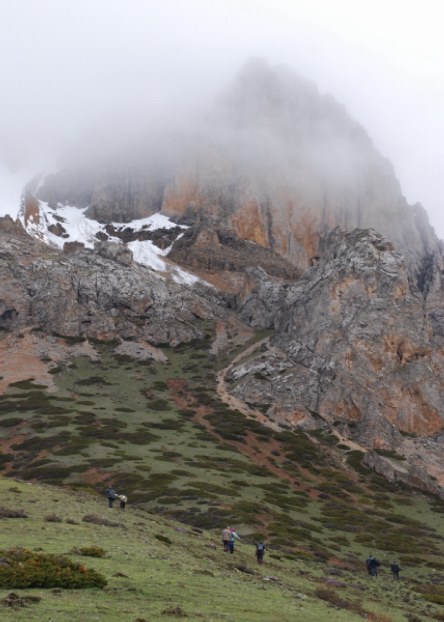 A group of caterpillar fungus collectors on their way to remote hunting grounds.
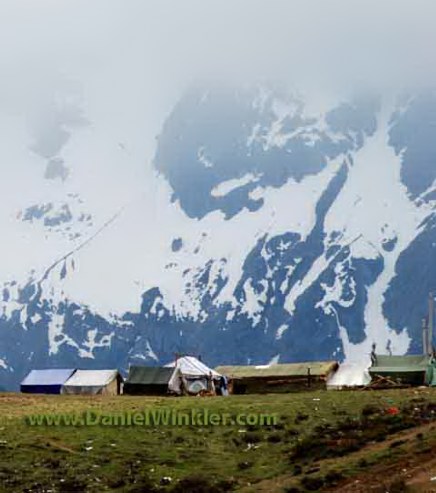 A caterpillar fungus collector camp above treeline. In the background Pema Karpo.
© Daniel Winkler, June 3, 2008, Dechen TAP, Yunnan
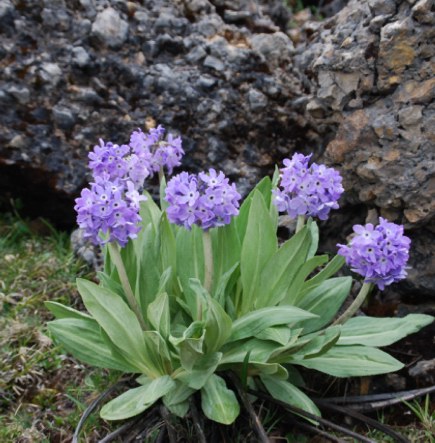 An alpine Primula. Many primulas are flowering at the same time as Cordyceps is fruiting.
|
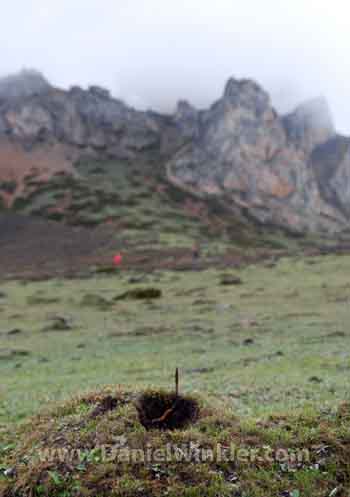 A Yartsa gunbu (Cordyceps sinensis) in its alpine habitat in the Tibetan areas of Northwest Yunnan. © Daniel Winkler, June 6, 2008, Dechen TAP, Yunnan
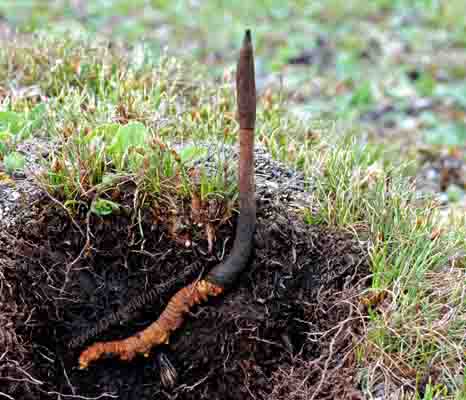 A caterpillar fungus half dug out in its typical habitat.
© Daniel Winkler, June 6, 2008, Dechen TAP, Yunnan
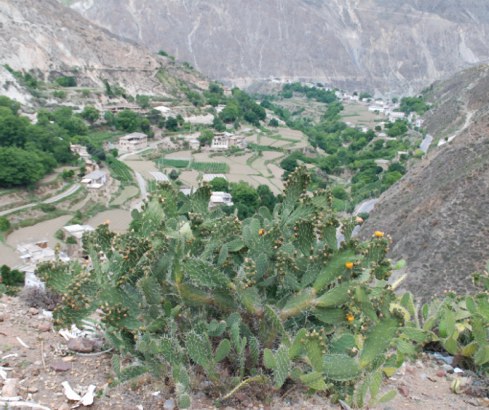 A prickly pear cactus (Opuntia ficus-indica) growing on a grazed slope. Prickly pears originate from Central America, probably Mexico, and have been naturalized in the dry warm valleys of southeastern Tibet. Down in the valley a village with the typical irrigated fields. Many former grain growing fields have been used to grow cash crops, such as walnuts, apples and a range of vegetable for Chinese consumers in Shangrila town.
|
7-Jun Sat Gyalthang via Kunming to Chengdu, Sichuan Province
Attempted visit of Sichuan's materia medica market. Visit of the Jinli Promenade and Tibetan Street.
Sichuan Hot Pot Fondue-Dinner with Drolma. Garden Hotel
8-Jun Sun Chengdu, excursion to Emei Shan and Leshan
Hiking on the sacred Mount Emei Shan from Wuxian to Twinbridges (Picnic site), Qingyin, Guangfu (910m, 2800ft) and Zhongfen Monastery (Ganoderma & Russula in the Cryptomeria japonica woods). Drive to Leshan, where the world biggest Buddha statue (71m, 233 ft), was carved from sandstone in the 8th Century at the confluence of Min Jiang and Dadu He Rivers. Farewell dinner in Thai Restaurant. Garden Hotel
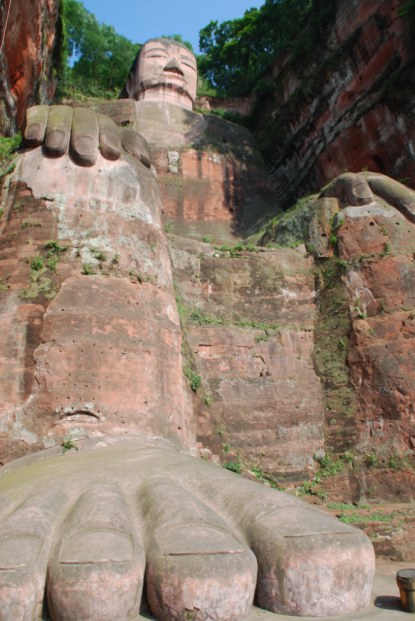 8th Century Leshan Sandstone Buddha (height 71 m, 233 ft). Lots of boats used to tip over right before the cliff which was turned into the giant Buddha. There is a confluence of the Dadu He and the Min Jiang, two huge Yangtze tributaries draining easternmost Tibetan areas. After building the Buddha it hardly happened. Of course materialists will say it probably was all changed by the debris in the water that change the run of the rivers at teh confluence. And it might very well be so.
|
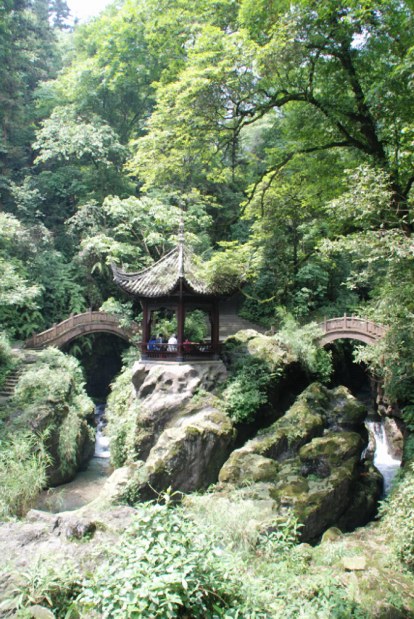 Emei Shan's Twinbridges with confluence
|
|
9-Jun Mon Chengdu
Group dissolves & flight back
|

